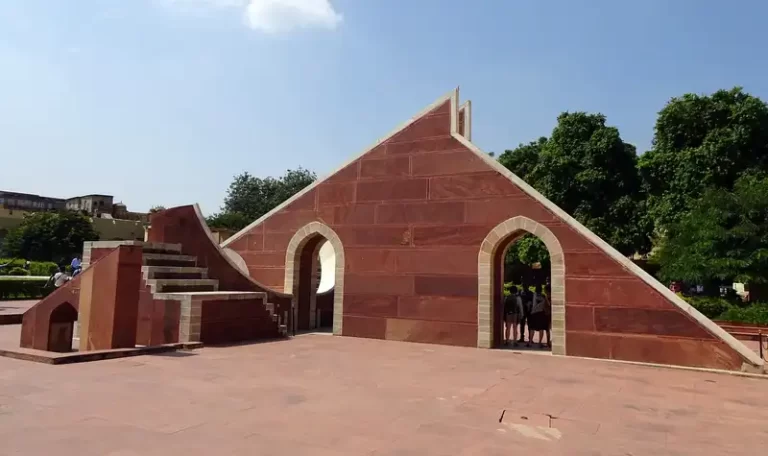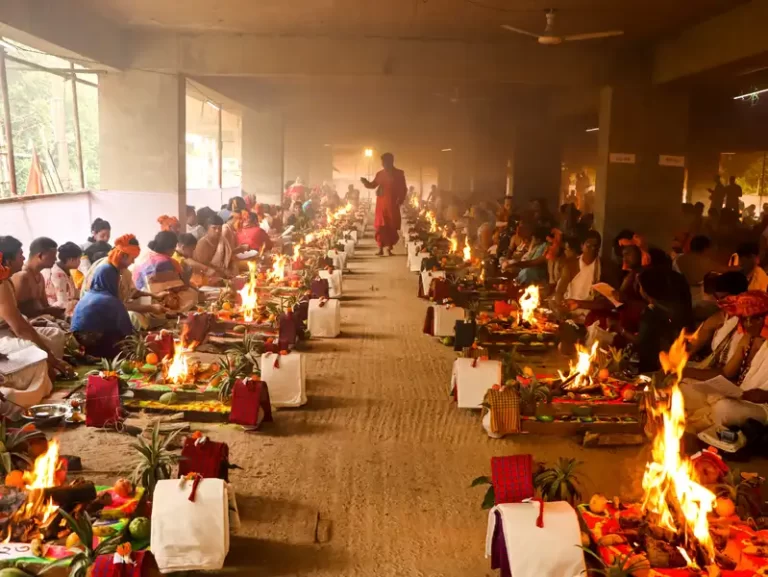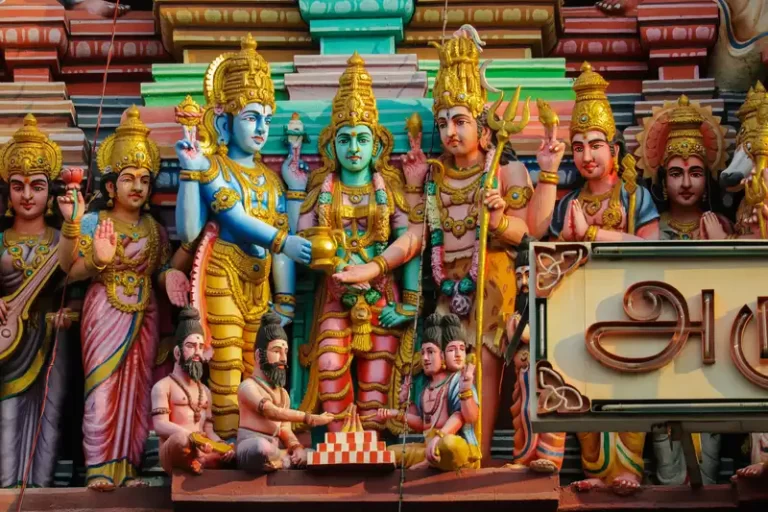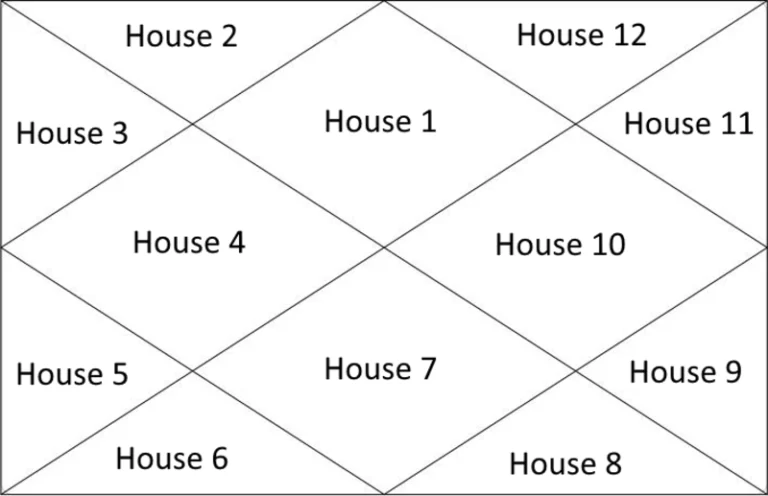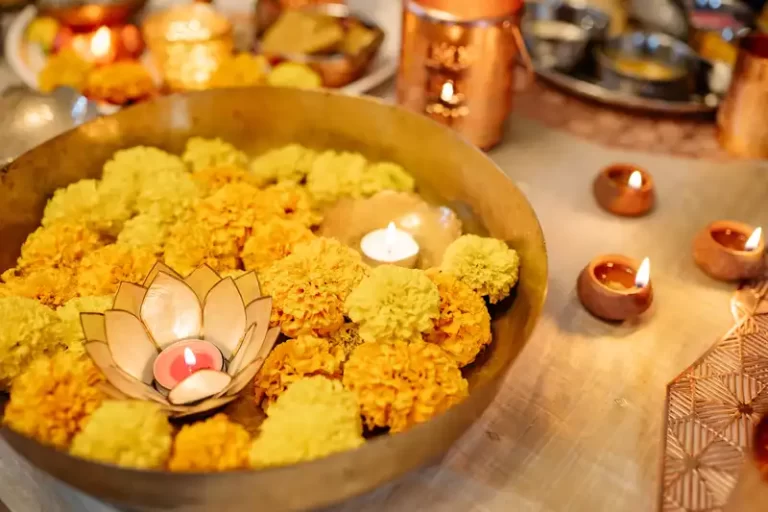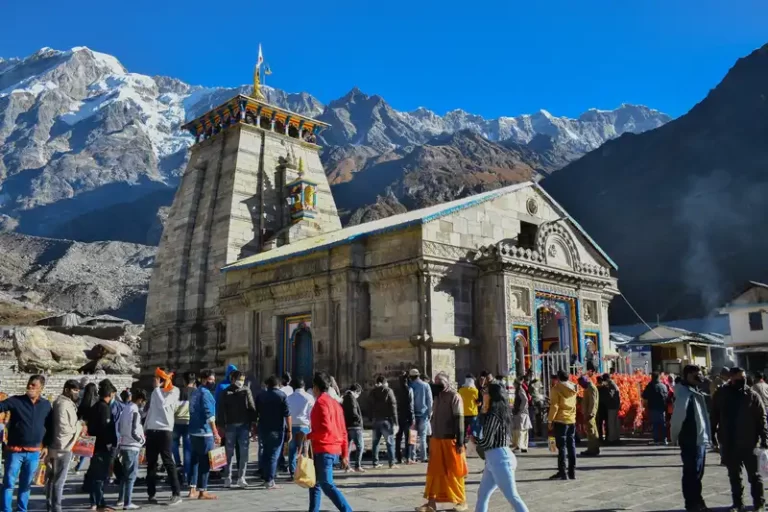Navdurga: the serene 9 forms of the Divine Mother
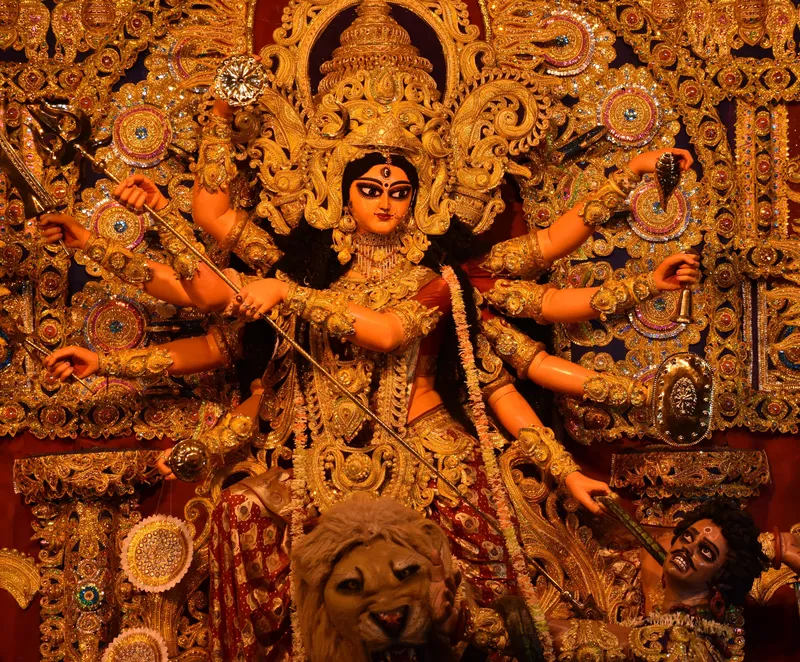
Introduction to the Navdurga:
Salutations to Navdurga, the embodiment of the divine feminine in Hindu mythology. Comprising a symphony of nine resplendent facets, Navdurga encapsulates the quintessence of the formidable goddess Durga. Within Hinduism, Durga commands veneration due to her indomitable might, unyielding valor, and unwavering shield of guardianship. She frequently manifests astride a regal lion or a majestic tiger, her myriad limbs adorned with an arsenal of potent weaponry.
During the sacred occasion of Navratri, a span of nine days is dedicated to the adoration of the Navdurga, encompassing the nine manifestations of Durga. This festival reverently commemorates the goddess, with each distinct form of Navdurga symbolizing a diverse facet of her being, carrying its own singular import and reverence.
Navdurga
प्रथमं शैलपुत्रीति द्वितीयं ब्रह्मचारिणी ।
तृतीयं चन्द्रघण्टेति कूष्माण्डेति चतुर्थकम् ॥
पञ्चमं स्कन्दमातेति षष्ठं कात्यायनी तथा ।
सप्तमं कालरात्रिश्च महागौरीति चाष्टमम् ॥
नवमं सिद्धिदात्री च नवदुर्गाः प्रकीर्तिताः ।
उक्तान्येतानि नामानि ब्रह्मणैव महात्मना ॥
Brahma himself articulated these appellations of the Navdurga, bestowing them with sacred resonance. The initial form is Shailaputri, signifying the “Offspring of Mountains.” Pursuant is Brahmacarini, immersed in austere contemplation. Subsequently, Chandraghanta, the celestial “Moon’s Toll,” and Kushmanda, the radiant nucleus of the Cosmic Ovum. Skandamata, mother of Skanda, graces as the fifth, while Katyayani, scion of Rishi Katyayana, emerges as the sixth embodiment. Kalaratri, the “Nocturnal Abyss of Annihilation,” embodies the seventh essence, and Mahagauri, the “Vast Luminous Ivory,” follows as the eighth. Ultimately, Siddhidatri, the granter of accomplishments, culminates as the ninth and final facet of the Navdurga.
The observance of Navdurga worship during Navratri is believed to invoke felicity, opulence, and shelter for adherents. Each Navdurga form corresponds to a specific day of Navratri, instigating devotees to enact distinct ceremonies, supplications, and offerings throughout this nine-day observance.
The Four Navratris:
Four distinct Navratris provide occasions to revere Navdurga throughout the year. These are:
- Chaitra Navratri – Honored in the Hindu month of Chaitra, spanning March-April, also known as Vasant Navratri. This festive period signifies the inauguration of the Hindu new year and the advent of spring.
- Ashadha Navratri – Dubbed Gupt Navratri, Ashadha Navratri unfolds in the Hindu month of Ashadha, between June-July. This Navratri, less prominent than its counterparts, finds observance primarily among spiritual seekers and ascetics.
- Sharad Navratri – Prevalent as the most celebrated Navratri, Sharad Navratri occupies the Hindu month of Ashwin, transpiring in September-October. This vibrant observance is steeped in devotion and zeal, heralding the commencement of India’s festive season.
- Magha Navratri – Manifesting during the Hindu month of Magha, spanning January-February, Magha Navratri is also recognized as Gupt Navratri. Herein, the focus remains on spiritual seekers and ascetics.
Chaitra Navratri heralds the initiation of the Hindu New Year, culminating with Ram Navami, the sacred day of Bhagwan Shri Rama’s birth. In parallel, Ashwin Navratri concludes with Vijaya Dashmi, the date commemorating Bhagwan Shri Rama’s triumphant vanquishment of Ravana.
Shailputri:
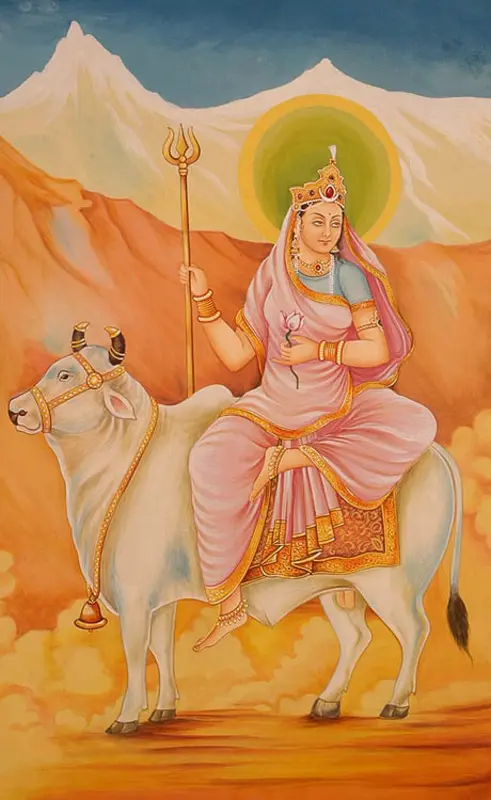
वन्दे वाञ्छितलाभाय चन्द्रार्धकृतशेखराम्।
वृषारुढां शूलधरां शैलपुत्रीं यशस्विनीम्॥
I pay homage to the illustrious Goddess Shailputri, who is adorned with a half-moon on her head, rides majestically on a bull, and wields a trident. She is the divine embodiment of power and strength, and I seek her blessings to fulfill my needs.
Shailputri, the maiden of the mountains, inaugurates the Navdurga tradition as the foremost manifestation of the Hindu goddess Durga. Also known as Sati or Parvati, she is venerated on Navratri’s inaugural day.
Her narrative intertwines with her birth to King Himavan and Queen Mena, representing her transition from her past life as Sati – the offspring of King Daksha, wedded to Lord Shiva. Sati’s self-immolation in a yagna fire, spurred by Daksha’s scorn for Shiva, shapes her destiny.
Reincarnated as Shailputri, she emerges as Himavan and Mena’s daughter, epitomizing the “daughter of the mountains.” Blossoming into the resolute Princess Parvati, she weds Lord Shiva.
A picturesque portrayal depicts Shailputri atop a bull, wielding a trident and cradling a lotus. Devotees invoke her on Navratri’s commencement, seeking her blessings for a propitious festival inauguration, beckoning stability, might, and equilibrium.
Shailputri’s veneration is linked to the expiration of previous karmas, paving avenues for spiritual advancement. Adherents who ardently revere her garner both material and spiritual prosperity, surmounting life’s obstacles and adversities.
Brahmacharini:
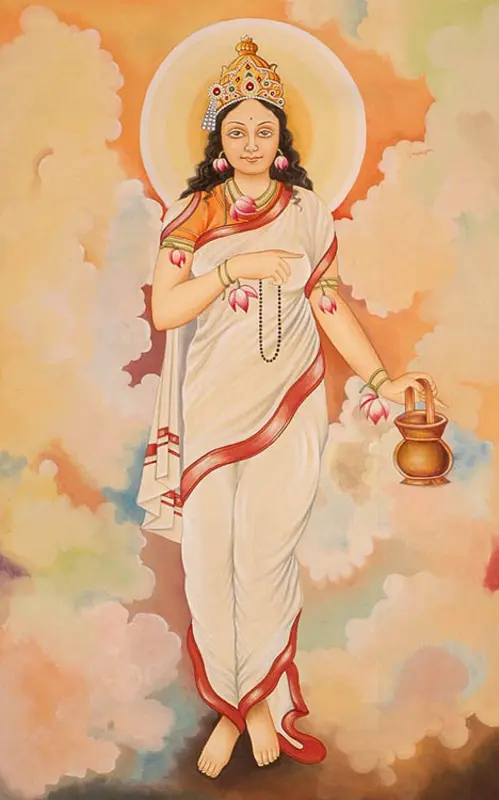
दधाना करपद्माभ्यामक्षमालाकमण्डलू।
देवी प्रसीदतु मयि ब्रह्मचारिण्यनुत्तमा॥
O resplendent Goddess Brahmacharini, adorned with a rosary and Kamandalu, I beseech your benevolence. As an ardent seeker yearning to fathom the divine and attain mastery, I revere you on this auspicious second day of Durga Puja. May your celestial blessings illuminate my way toward spiritual awakening, endowing me with the sagacity and insight to fulfill my aspirations.
Brahmacharini, the second emblem of the Hindu goddess Durga within Navdurga, occupies veneration on Navratri’s second day, resonating with immaculacy, celibacy, and piety.
Her renown stems from penance, unwavering devotion, and austere practices, culminating in extended meditation upon Lord Shiva to secure his companionship.
In her portrayal, Brahmacharini stands as a two-armed deity, clutching a rosary and a water vessel. She treads unshod, embodying purity’s essence and the puissance of allegiance. Her meditative journey and austerities garnered Lord Shiva’s pleasure, culminating in his blessings and the bestowal of her desire to be his consort.
Invoking the Brahmacharini aspect of Navdurga is believed to conjure purity, devotion, and resilience for devotees. The blessings of this form are thought to empower individuals to surmount life’s trials and tribulations, ushering spiritual and material opulence.
Chandraghanta:
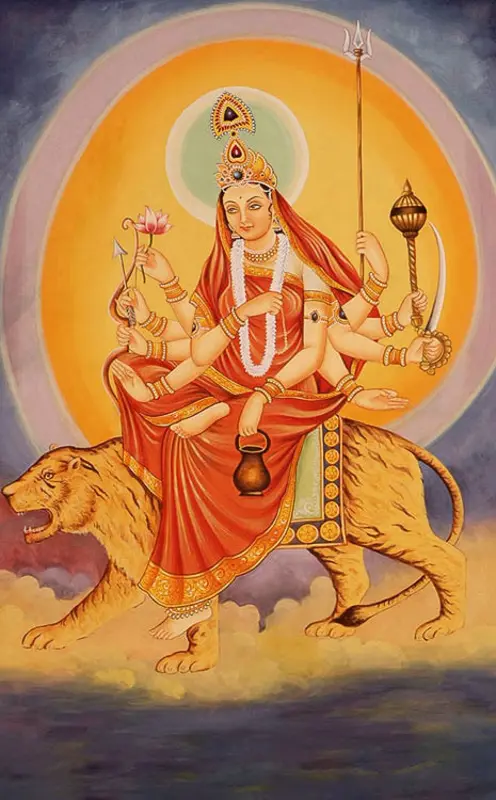
पिण्डज प्रवरारूढ़ा चण्डकोपास्त्रकैर्युता।
प्रसीदम तनुते महयं चन्द्रघण्टेति विश्रुता।।
Oh revered Goddess Chandraghanta, astride the regal tiger, adorned with an arsenal of weapons in your ten hands, I implore your grace. As a devotee confronting life’s trials and adversaries, I venerate you on this sanctified third day of Durga Puja and Navratri. May your celestial prowess dispel fears and hurdles from my path, enveloping me in your safeguarding aura. With your invincible valor and just wrath against foes, lead me to surmount all challenges and emerge triumphant.
Chandraghanta, the third manifestation within Navdurga, is venerated on Navratri’s third day, embodying valor and audacity.
The moniker “Chandraghanta” alludes to her crescent moon-shaped bell-like forehead ornament. The imagery presents her as a ten-armed deity, astride a lion or tiger, armed with a sword, trident, bow, and arrow. Adorned with a crescent moon on her brow.
Chandraghanta’s tale intertwines with her union with Lord Shiva. Brahmacharini’s devotion metamorphosed her into Chandraghanta. Following their matrimony, she emerged as a fierce combatant, mounted on a lion or tiger, combating malevolence. The crescent moon on her forehead symbolizes her intrepid spirit.
Invoking the Chandraghanta facet of Navdurga is believed to yield fortitude, valor, and sanctuary for devotees. Her blessings embolden individuals to surmount trepidation and adversities, bestowing triumph and affluence.
Kushmanda:
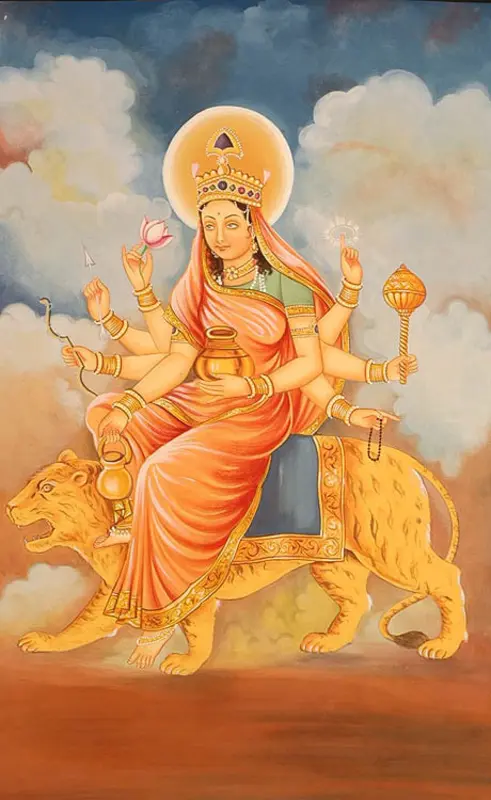
सुरासम्पूर्ण कलशं रुधिराप्लुतमेव च।
दधाना हस्तपद्माभ्यां कूष्माण्डा शुभदास्तु मे॥
Oh celestial Goddess Kushmanda, clasping vessels of Madira and vital essence within your lotus-like digits, I beseech your favor and inspiration. As the mother of the sun, you are the architect of the cosmos and the solar order. Devotees revere you to garner triumph in existence and to embrace your celestial benevolence. May your blessings steer me towards opulence, elation, and spiritual plenitude. With your divine vigor, may you empower me to surmount barriers, guiding me towards a life suffused with delight and serenity.
Kushmanda, the fourth facet within Navdurga, garners reverence on Navratri’s fourth day, embodying vitality and well-being.
The appellation “Kushmanda” evokes the notion of the universe’s originator. According to Hindu lore, Kushmanda’s divine smile birthed the cosmic egg from which the universe sprang forth, akin to a married woman with a child.
Kushmanda’s portrayal often features her with eight or ten arms, astride a lion or tiger. Her creation of the universe through her celestial grin attributes her with a smiling visage. She is also depicted wielding diverse arms and items, including a bow, arrow, discus, and mace.
Invocation of the Kushmanda form of Navdurga is believed to confer robust health, vigor, and vitality upon devotees. Her blessings purportedly guide individuals to surmount physical and mental ailments, ushering in longevity and abundance. Furthermore, her devotees are believed to gain sagacity, make astute choices and attain prosperity in their endeavors.
Skandamata:
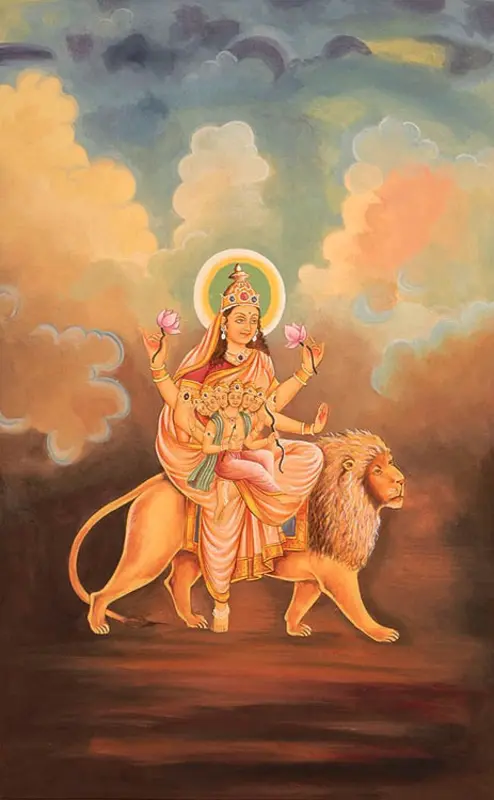
सिंहासनगता नित्यं पद्माश्रितकरद्वया I
शुभदास्तु सदा देवी स्कन्दमाता यशस्विनी II
Oh gracious Skandmata, mounted on a lion, accompanied by Kartikeya, cradling a lotus in your tender grasp and a Varmudra in one hand, I earnestly seek your auspicious blessings. As the celestial mother nurturing devotees as her own offspring, I revere you, particularly amidst life’s constraints and hindrances. May your celestial favor and guardianship illuminate my route to triumph and satisfaction. With your maternal affection and solicitude, obliterate barriers and aid me in realizing my intrinsic capabilities.
Skandamata, the fifth embodiment within Navdurga, garners devotion on Navratri’s fifth day, symbolizing motherhood and fecundity.
The name “Skandamata” alludes to her role as the mother of Skanda, an epithet for Lord Kartikeya, the valiant warrior astride a peacock.
Skandamata is often portrayed as a four-armed goddess, cradling her son Skanda on her lap. Additionally, she holds a lotus flower and a bell. Her mount varies between a lion and a tiger.
Skandamata’s narrative intertwines with the birth of Lord Kartikeya. In the face of the demon Tarakasura’s menace, the gods beseeched Lord Shiva for assistance. Amid his meditation, Lord Shiva was unresponsive, and Kartikeya, aided by his mother, overcame Tarakasura, restoring tranquility.
Invocation of the Skandamata aspect of Navdurga is believed to confer maternal blessings and fertility upon devotees. Those who seek her benediction are said to be blessed with familial joy and prosperity, surmounting hurdles linked to childbirth and nurturing. Moreover, her devotees are thought to receive courage and protection through her blessings.
Katyayani:
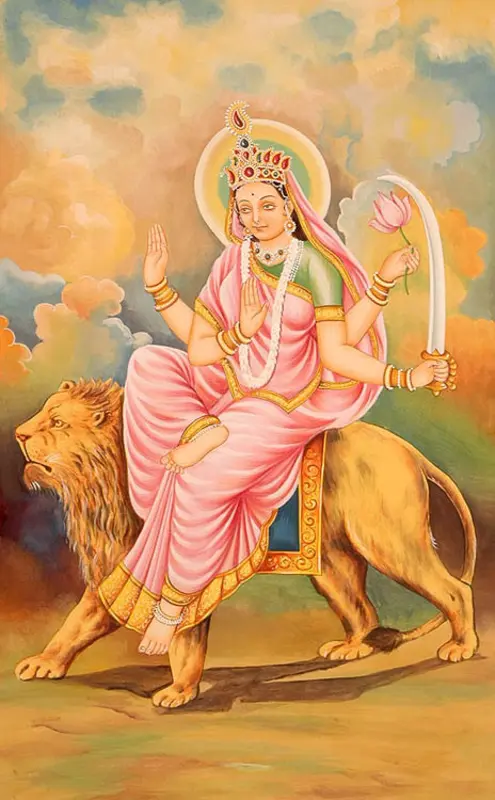
चन्द्रहासोज्ज्वलकरा शार्दूलवरवाहना।
कात्यायनी शुभं दद्याद् देवी दानवघातिनी॥
Oh potent Devi Katyayani, wielding the Chandrahas sword and an array of arms, unyielding upon a lion’s back to vanquish demons, I ardently implore your favorable benedictions.
Katyayani, the sixth embodiment within Navdurga, is revered on the sixth day of Navratri, epitomizing love and devotion.
Her appellation “Katyayani” finds its roots in Sage Katyayana’s name, who ardently worshiped Durga. Legend holds that Katyayani manifested from divine wrath to confront the demon Mahishasura.
Katyayani is often portrayed with four arms, wielding a sword and a lotus, while extending the other two in gestures of benediction and safeguarding. She rides a lion or tiger.
Her tale entwines birth and the struggle against Mahishasura. Bestowed with invincibility against male deities by a boon from Lord Brahma, Mahishasura posed a formidable challenge. The gods, crafting Katyayani from their collective rage and energy, empowered her to vanquish Mahishasura over nine days and nights, sealing triumph on the tenth.
Invocation of the Katyayani form of Navdurga is believed to usher blessings of ardor and devotion. Her devotees purportedly surmount relational hurdles and bask in harmonious connections. Moreover, her blessings are thought to empower individuals to confront negativity and malevolence with resolve and courage.
Kaalratri:
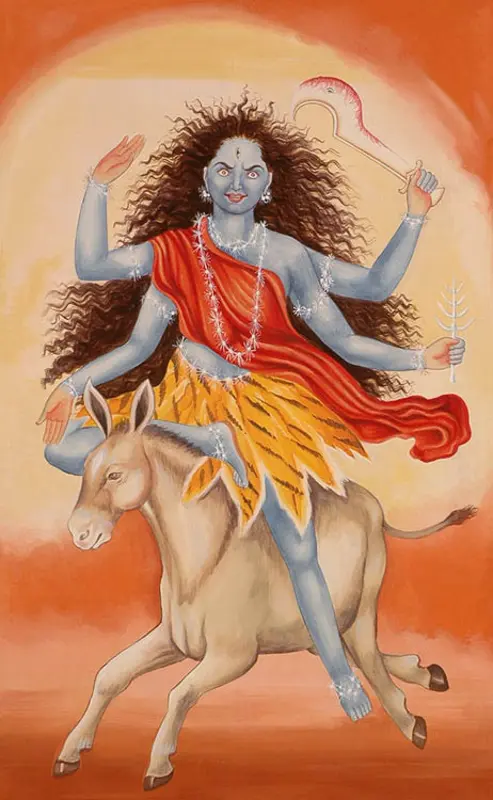
एकवेणी जपाकर्णपूरा नग्ना खरास्थिता।
लम्बोष्ठी कर्णिकाकर्णी तैलाभ्यक्त शरीरिणी॥
वामपादोल्लसल्लोह लताकण्टकभूषणा।
वर्धन मूर्धध्वजा कृष्णा कालरात्रिर्भयङ्करी॥
This mantra elucidates the aspect of Kalratri, fostering meditation upon her unique form. Imagery presents her as unclothed, astride an ass, featuring lustrous lips and a radiant physique. Lightning-like ornaments grace her legs, while her complexion is dusky, hair cascades unconfined, eyes are profound, and ears are prominent. Contemplation upon Kalratri in this embodiment is believed to dispel hindrances and provide defense against malevolent black magic wrought by others.
Kaalratri, the seventh embodiment within Navdurga, commands reverence on the seventh day of Navratri, encapsulating themes of destruction and metamorphosis.
“Kaalratri,” translated as “the dark night,” bears layers of symbolism, with “Kaal” signifying Death or Time. Portrayed as an awe-inspiring goddess with long hair and a dusky complexion, she possesses four arms, wielding a sword and trident in two hands, while the other two extend in gestures of safeguarding and benediction. She mounts a donkey.
Kaalratri’s narrative aligns with her role in dismantling malevolence. She is hailed as the fiercest, most potent form of Durga, embodying the forces of death and transformation. Her essence transcends to obliterating ignorance, fear, and darkness, emblematic of profound change.
Invoking the Kaalratri facet of Navdurga is believed to bestow blessings of transformation and evolution. Those who seek her grace purportedly conquer apprehensions and negative proclivities, embracing life’s changes. Moreover, her blessings embolden individuals to combat their inner struggles, emerging victorious.
Hindu lore portrays Shiva invoking Kaalratri in his formidable Bhairava form, as they together vanquish malevolence and shield the cosmos.
Mahagauri:
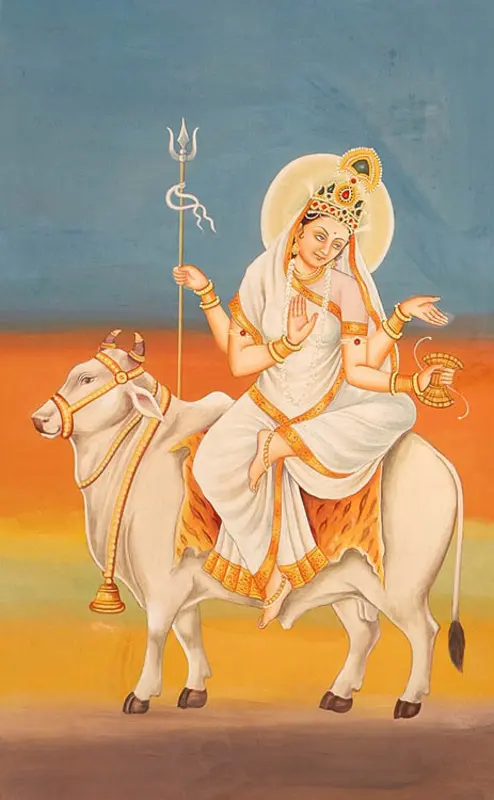
श्वेते वृषेसमारूढा श्वेताम्बरधरा शुचिः।
महागौरी शुभं दद्यान्महादेव प्रमोददा॥
Oh benevolent Goddess Mahagauri, mounted upon a white bull, bedecked in pristine white attire, I earnestly beseech your auspicious blessings. As the bestower of joy and contentment, I revere you with ardent devotion and reverence.
Mahagauri, the eighth embodiment within Navdurga, evokes devotion on the eighth day of Navratri, embodying purity and illumination.
The name “Mahagauri” translates to “exceptionally white” or “intensely luminous.” She is often depicted as a resplendent goddess with four arms, draped in a white saree and mounted on a white bull. A trident and tambourine grace her hands, while the others extend in gestures of benediction and safeguarding.
Following the quelling of ignorance and malevolence, the divine mother reverts to her customary form as an ideal mother and spouse, bestowing blessings upon all.
Invoking the Mahagauri aspect of Navdurga is believed to yield purity and enlightenment blessings. Devotees seeking her grace allegedly cleanse their thoughts and deeds, attaining spiritual enlightenment. Additionally, she is believed to confer the power of healing, aiding in the transcendence of physical and mental afflictions.
Siddhidatri:
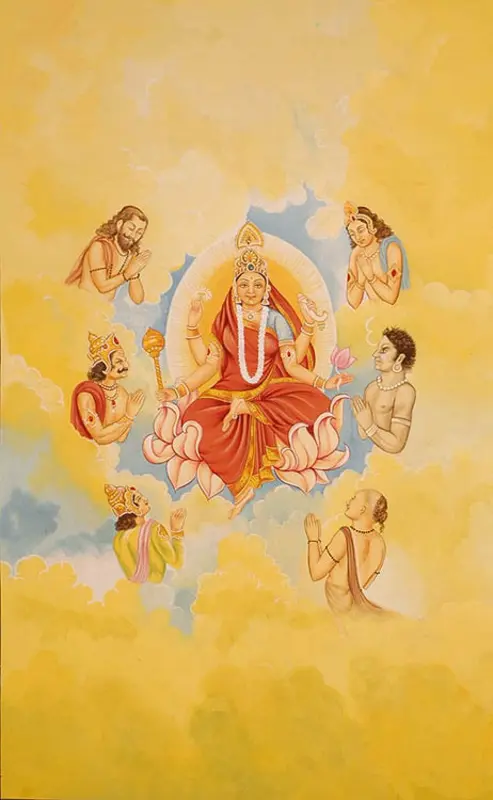
सिद्ध गन्धर्व यक्षाद्यैरसुरैरमरैरपि।
सेव्यमाना सदा भूयात् सिद्धिदा सिद्धिदायिनी॥
Oh magnificent Goddess Siddhidatri, revered by Siddhas, Gandharvas, Yakshas, Deities, Demons, and myriad others, I earnestly implore your favorable blessings. Grasping the Conch, Chakra, Gada, and Lotus in your hands, you are the bestower of all siddhis, ensuring triumph for those who seek your grace. As a devout adherent, I beseech you with utmost humility and pray for your celestial favor.
Siddhidatri, the ninth and culminating embodiment within Navdurga commands devotion on the ninth day of Navratri, embodying otherworldly faculties and benedictions.
The name “Siddhidatri” signifies the “granter of all Siddhis,” denoting metaphysical powers attained through spiritual dedication. Portrayed as a resplendent goddess with four arms, she clutches a lotus, mace, conch shell, and discus in each hand.
Siddhidatri’s narrative aligns with her bestowal of supernatural abilities and blessings to her adherents. Her purported ability to fulfill their aspirations and bestow spiritual illumination is revered.
According to Hindu lore, Lord Shiva engendered Siddhidatri from his third eye. She embodies the totality of divine prowess, revered as the ultimate fount of creation.
Invocation of the Siddhidatri aspect of Navdurga is believed to confer blessings of spiritual enlightenment and extraordinary powers. Those who seek her grace allegedly attain diverse Siddhis, encompassing curative powers, telepathy, and clairvoyance. Additionally, her blessings are believed to bring opulence, prosperity, and triumph in all ventures.
According to Hindu legend, worship of the Siddhidatri form of Navdurga is believed to lead to ultimate liberation or Moksha, releasing the soul from the cycle of rebirth and death to attain perpetual serenity and bliss.
Conclusion:
Annually, multitudes of Hindus engage in Navratris, fervently venerating Navdurga. Embracing female divinity as the primal source of Shakti, Hindus earnestly seek Navdurga’s blessings. Navratri’s span witnesses fasting, puja rituals, melodic bhajans, and cultural festivities. This celebration reverberates with the conquest of virtue over malevolence, nurturing spiritual and individual maturation.
I aspire for this article to provide you with assistance. Should you discover value within these words, kindly contemplate sharing them with your loved ones. I invite you to spare a moment to offer your thoughts and appraisals below. For further remarkable content akin to this, I encourage you to delve into our website. Additionally, I extend an invitation to subscribe to my YouTube channel for forthcoming materials of similar nature. Lastly, feel unrestrained to establish a connection with me through social media. Wishing you a splendid day ahead!
हरि ॐ तत्सत्
FAQs:
Frequently Asked Questions (FAQs) about Navdurga:

